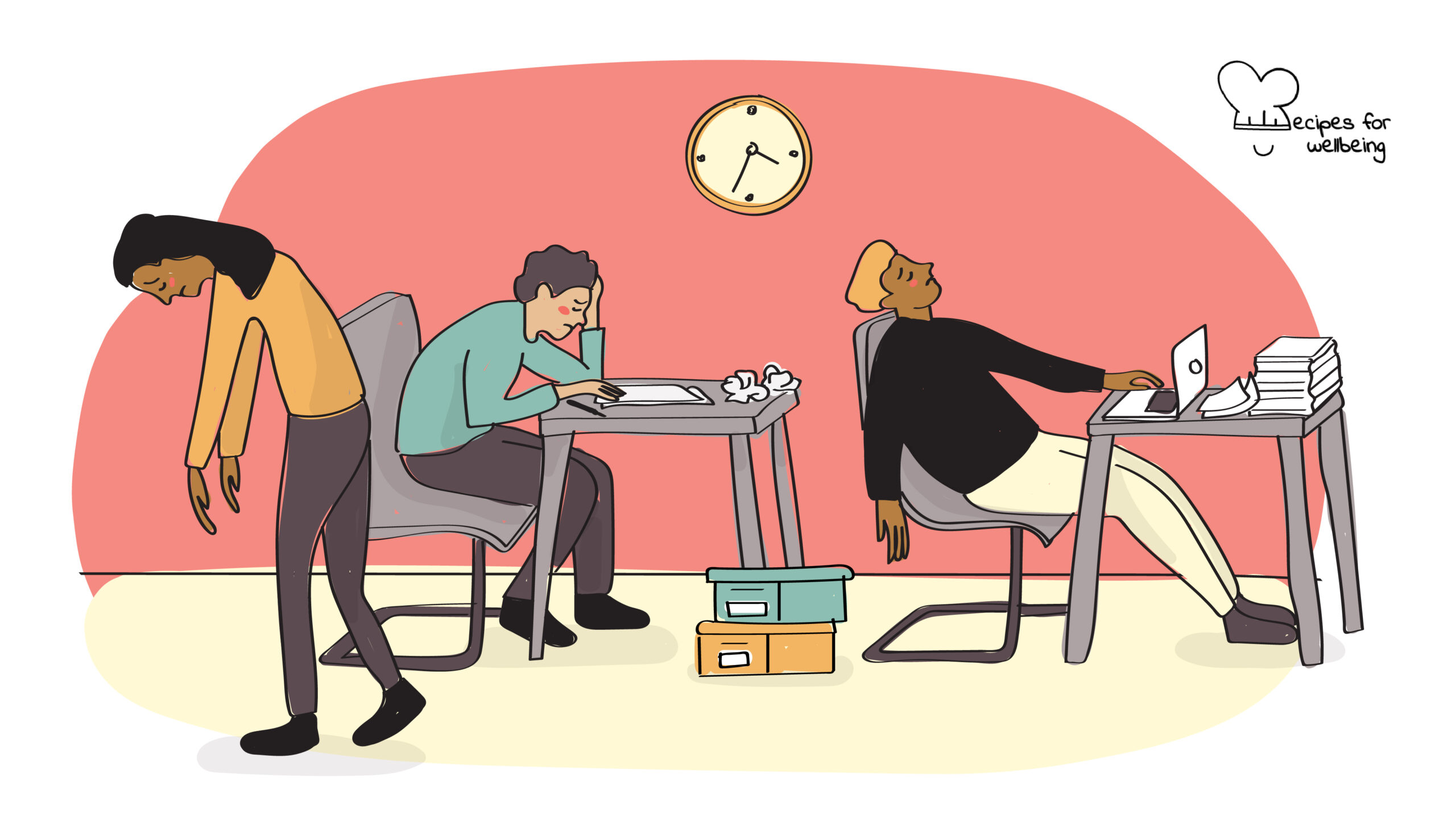
6 red flags of burnout
Burnout, like any difficult experience, is a great teacher. My question is: what is it trying to tell you? ―Dr Rebecca Ray
👥 Serves: 11-25 people, 2-10 people, 26-40 people, 41+ people
🎚 Difficulty: Medium
⏳ Total time: 61-120 minutes
🥣 Ingredients: Empathy, awareness
🤓 Wholebeing Domains: Community, Discomfortability, Positive Emotion, Radical Care, Rest
💪 Wholebeing Skills: Belonging, Boundary setting, Giving, Kindness, Pausing, Seeking support, Self-regulation, Stress management

6 red flags of burnout
📝 Description
Notice red flags in your team to avoid burnout.
Organisational leaders have the responsibility to foster a positive and balanced workplace to decrease stress and prevent their team from experiencing the dangers of burnout. Without careful interventions, burnout can cause:
- Excessive stress
- Fatigue
- Insomnia
- Sadness, anger or irritability
- Alcohol or substance misuse
- Heart disease
- High blood pressure
- Type 2 diabetes
- Vulnerability to illnesses
This recipe invites organisational leaders to reflect on six key questions to identify unhealthy behaviours that can lead to burnout, as well as presenting solutions to avoid it. If you are new to this concept, we invite you to read our recipe “6 causes of burnout” and to run a quick self-assessment to determine your level of wellbeing and burnout with our recipe “Burnout and wellbeing scale”.
This recipe has been inspired by the work of Dr Lisa Belanger, PhD in Behavioural Medicine, Executive MBA, a Certified Exercise Physiologist and High-Performance Specialist, and adapted by our wellbeing content writer collaborator Marissa Del Mistro.
👣 Steps
Step 1 – Does your team regularly miss breaks? (20’)
Everyone needs breaks in their workday (including you!). Sometimes, during busy periods or before important deadlines, your team might sacrifice their breaks. Doing so every so often is not a problem, but if this is a normal occurrence it becomes precarious.
To avoid this, you need to assert strong boundaries to ensure breaks are a priority in the workplace.You can do this by:
- Leading by example – take breaks yourself, and encourage team breaks such as walks, coffee breaks, or mindful exercises. You can find additional inspiration in our recipe “Creating the right workspaces”.
- Having 1:1 conversations with team members that are neglecting breaks regularly. You can do this digitally or in person.
- Ensuring you are managing team members’ workloads effectively, so no one is taking on more work than is realistic.
- Make a ‘lunch-away-from-the-desk rule’ to avoid people working through their lunch break.
- Encouraging micro-breaks or regular breaks with the “Pomodoro® Technique for Wellbeing” tactic. However, be mindful that different people have different needs so do not impose “one way” of taking breaks.
- Reducing the number of meetings and shortening them (25 instead of 30 minutes or 50 instead of 60 minutes) so team members always have a buffer in-between.
Step 2 – Does your organisation have clear expectations? (20’)
Your team needs to know that as an organisation you prioritise wellbeing and want all of your team members to thrive. This can be solidified through policies and action plans around preventing burnout, flexible working options and other wellbeing policies. Your employers must know that the work culture is one where they know how to ask for help and that when they do, they will receive it.
In addition to creating policies, you should regularly address priorities around burnout and wellbeing. This can be done in team meetings but should be reiterated during 1:1 meetings. You can use our recipe “Developing new wellbeing frameworks” to ensure any new policies are infused with wellbeing.
Step 3 – Has productivity decreased? (20’)
People’s productivity experiences ebb and flow – but it can be a major red flag indicating burnout if you see a distinct change in productivity or performance.
The main way to approach this is through an empathetic and non-judgemental conversation. Focus on the human, not on the work – pay attention to what the person is going through, rather than how they let their performance slip. After empathising, you may also wish to explore ways to support these people: do they need time off? Can the workload be re-distributed? Do they need additional support? Would flexible working help? Check out our recipe “Talking mental health in the workplace” for some tips.
Step 4 – Is the team disengaged? (20’)
Similar to step 3, step 4 also highlights just how important it is to be aware of any changes in your team members’ behaviours. If you have a team member whose attitude or engagement shifts, it may be a sign of burnout. Things to watch out for as a leader: if someone mostly keeps their camera off during online meetings, or they keep their hand in their hands, or they are constantly sighing or appear frustrated. Disengagement can also show up as cynicism or being overly negative towards new project ideas or activities.
It is important to not take these situations personally, but they do need to be addressed. Start by engaging in a conversation to determine what can be done, while focussing on wellbeing and health over everything.
Things to consider in this instance:
- Offer time off as mental health days, which can be in line with your burnout prevention policies mentioned in step 1.
- Discuss training opportunities if the team members feel unprepared or overwhelmed by the nature of the work.
- Determine if the team members would benefit from any flexible working arrangements.
- Arrange mental health support including subsidised therapy.
Encourage team building and bonding during work hours by way of a wellness afternoon once a month and/or weekly sessions such as yoga (it can be chair yoga to be more accessible).
Step 5 – Is the workload reasonable? (20’)
One of the main tasks of a leader is to leave people better off working for the team, not to deplete them! It is imperative leaders understand that what one person can handle – is not universal and everyone can manage different things at different speeds.
Rather than making assumptions about what one can do, work closely with your team member to determine workload, which helps to develop increased autonomy and responsibility. Support your team in managing deadlines and prioritising, reducing or eliminating unnecessary tasks. Read our recipe “Tips for time management” for dedicated tips.
Always remain in constant communication with your team, and be sure that as a team leader you are initiating conversations and fostering an environment where your team feels safe and comfortable approaching you to address any concerns that they are having. It is also important to ensure the target and priority of tasks are not constantly changing. Without a priority and understood target, it can lead to increased and undue stress. More suggestions to tackle unmanageable workload can be found in step 2 of our recipe “6 causes of burnout”.
Step 6 – Are you getting the training and support you need? (20’)
Therapists are a great example of step 5. As part of their job and to keep their therapy certifications to practise, they must meet with other qualified therapists regularly to address challenges in their lives and balance their work-life balance.
Strong leaders must do the same, ensuring they are getting the support they need to keep things running like a well-oiled machine. This will differ for different organisations but here are a few ideas you may wish to consider:
- Regular training to upscale your skills.
- Diversity, inclusion and equity training to support in understanding best practice when working with other people. This includes understanding and respecting differences in sexual orientation, gender identity, nationality or national origin, religion, physical abilities, neurodiversity, and age.
- Mental health first aid certification to identify and tackle mental health crises.
- “Optimistic leadership” to foster positivity, accountability, and adaptability in your work culture.
- Additional recipes that might be useful include “Identifying bias in performance evaluations”, “Strategies to support LGBTQIA2S+ folks in the workplace”, and step 6 of our recipe “6 causes of burnout”.

